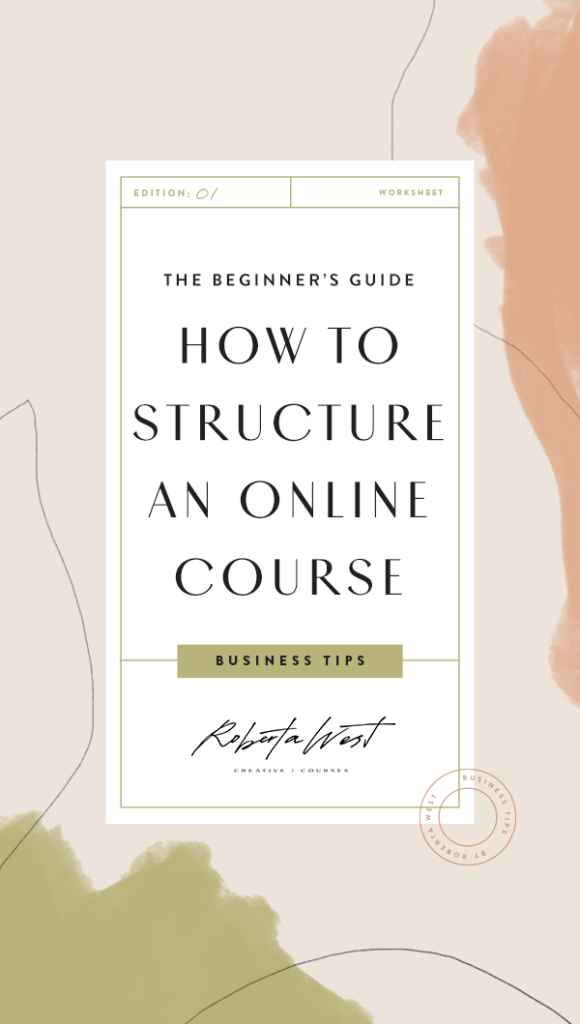
After decades of assisting experts in course creation, I have discovered that the part most of them find difficult is structure and organization. They usually have all their resources in one huge, unorganized lump.
Before anything else can be done, I must systematically go through these resources and structure them in a way that effortlessly flows from module to module to enhance comprehension for students.
To help course creators, I have created a complete project plan on structuring an online course in the most effective way.
Even as a beginner, you can adopt this plan for your own course creation while providing valuable and engaging content to all your learners. I have written this article, born from my wealth of experience, so you can know what works and what doesn’t when it comes to the structuring of online courses.
What Is Structuring An Online Course?
Structuring an online course is essentially about organizing your course to ensure your audience has the easiest learning experience. As revealed in a recent survey, three out of ten Americans prefer to take a course online than attend a physical class.
This increased flare for online courses can be linked to an increase in people wanting to learn new skills online. That being said, learners also want to learn quickly and with ease.

In structuring an online course, strive to help your audience achieve that ease by providing them with an easy-to-follow course. This is done in the way you organize your content into modules using resources such as templates and tools to structure your online course.
You should enable easy access to all of your materials, divide your course into sections, and adequately provide an easy method to evaluate your learner’s progress.
It is very easy to focus too heavily on how to make learners interested in your course. This feeling sometimes pushes creators to stuff their course with more content than needed, all in a bid to provide a comprehensive experience.
However, creating a course that’s worth your student’s money is not primarily about creating tons of content. Offering value to your student and properly structuring your content is the most important part of course creation.
You can strategically create an online course structure and provide valuable, engaging content while avoiding overwhelming your learners with content overload.
A course structure is a framework for your content and this provides a stronger and deeper learning experience. It creates a clear pathway which your learners can follow to achieve the basic learning outcomes.
How To Get Started With Structuring An Online Course
To get started with creating a logical course structure, have in mind your learning aims and the intended outcomes.
The learning outcome, also known as the objective, is what your audience gets from taking your online course from the beginning to the end. The objective is your ‘why’ for creating a course.
Once you have figured out your objectives, then you can begin the process of developing an online course.

The two questions included below: “What do you want to cover?” and “What type of content do you want to use?” are very important for organizing your course into more comprehensible and engaging chunks.
However, if you don’t have an objective, you will not be able to answer these questions appropriately.
What Do You Want To Cover?
Discussing a subject matter can be so vast that it may take an eternity to complete without an appropriate structure or outline.
You might create content and then suddenly realize that you didn’t include several specific parts. If this happens to you, or if you are worried about this, it is totally normal.
Sometimes, you just can’t possibly cover all there is about a subject matter in one course.
Before creating a course outline, you have to highlight what your scope for the course is. How far would you like to go on the topic? How much do you want your audience to learn?
You shouldn’t start creating course content without having a full mental picture of your course framework. Then, you should know how to approach and tailor your online course to your intended audience, which will invariably determine your writing style, course details, and length.
For instance, you can decide if you want your course tailored to beginners, intermediates, or experts. This will go a long way to help you streamline your course, and help your students have a better learning experience.
What Type of Content?
The content type is the procedure you want to take to teach your course and present information. There are different content types such as written (PDFs, e-books), front-to-camera videos, voiceover slides, and voice only.,
You can utilize more than one content type for your course. Decide which content type would best present the information that you want to teach.
For example, if you are writing an e-book and you need to include supporting or reference material in your course, you could put it in a PDF or text format.
You can also include a text format if this method would help your audience learn better, for example, when including a list or step-by-step instructions. If it’s possible, you can include a video for visual learners or an audio format for those who find reading cumbersome.

The type of training you are presenting should be thoroughly considered when you are choosing a content type. Keep in mind that the types of content you choose for your course will also affect the structure and style of your course material.
Organizing Your Thoughts: Create an Outline
After you have determined your course scope and content type or types, here are some step-by-step processes and guidelines to create an outline:
- Decide the timespan for your course and create a timeline, i.e., a week, three weeks or more.
- Determine the kind of method that best aids your student’s understanding. This could be a step-by-step learning process, or a daily or weekly framed learning process. It can also be a plain course outline format that is largely dependent on your audience's learning speed.
- Divide your course content into modules or sections
- Under each module, group similar ideas that express similar thoughts or messages into subtopics
- Try not to skip a step as you go along
- Consider organizing your modules by difficulty level. Your course content should be structured for the right audience and could be designed for beginners, intermediates, and/or experts
- Be mindful of the type of content(s) you are using to create your course. For example, if you are using videos, the videos should be short, with catchy graphic designs, and could include subtitles.
- Keep your writing simple, clear, and direct
- Create exercises and an evaluation or assessment format. This could be:
- After each module
- At the end of the whole course
- Make use of readymade templates for content creation. Some of the most effective template sources are listed below (including Launch In Style and Kajabi).
- Decide if you are going to include links to extra resources, reference articles, or your own website and social media account.
- Lastly, include a discussion forum (like Facebook group or private forums like Slack or Voxer). It enables your audience to engage with other people who are taking the course, ask questions, and build meaningful relationships that improve learning outcomes.
Knowing Your Audience And Their Learning Style
Research has shown that about 59% of the US e-learning community is composed of online course creators. More than 50% of students expressed that they found learning online more engaging than learning in the classroom.
This means that there is a big audience ready for online courses.

It is most important for any course instructor that the online course created reaches the right audience.
But what happens if you provide your course to that audience, and they are unable to relate to it? Therefore understanding who your audience is, as well as their learning style, is very important while structuring.
People often wonder how they can best create an online course. There are no hard and fast rules for creating a course outline.
The fundamental rule is to put yourself in the mind of your audience and think of what methods would benefit them the most from the online course.
For example, while organizing your training course outline template, you can ask yourself questions like:
- What is the age range of my audience?
- What teaching aids and methods will they be most attracted to?
- How much time do they have on average to take a course?
- Will they be willing to engage in certain activities I include in this course?
As you answer these questions, you will realize how to make your course more engaging and suitable for your specific audience.
Recommended Tools/Resources
In recent times, utilizing the right tools and resources has made it easier and time-saving when structuring an online course. Here are some resources that you should check out:
Launch In Style
Launch in Style shows how you can make more impact with your course structure and make your content more appealing to your audience. This tool will help you structure your online training course with resources for improving the look of your page, finding impactful fonts, and creating content.

No Limit Creative
Just like its name, this tool proves you have an unlimited capacity as a course creator. If you want to create a course using infographics or videos, you don’t have to bother employing a graphic designer or video editor.
No Limit Creative provides you with numerous course outline templates for creating graphic designs and videos.
The interactive way the templates are produced will also help you to bring your visuals to a professional-looking state, even if it’s your first time using the tool.
Kajabi
Never underestimate the power of click and drag. Using Kajabi gives a professional look to your course. It includes various options you can utilize so it appears that you contracted professional graphic or web designers for the whole process.
The tool contains ready-made templates that you can use to create your content. It also provides templates for building a website for your course to enable easier access to your course materials.
BluChic
The BluChic tool stands out as one of the most readily customizable content creation template providers. With BluChic, you can explore thousands of materials for content creation.
It provides access to WordPress themes, Canva templates, add-on templates, funnel templates, and many more.
This tool will enable you to create an online training course with ease. As a beginner, BluChic is a best practice online course design source and a top choice to guide you in structuring your online course.
The Template Tribe
The Template Tribe is a Canva template monthly membership that offers you access to easy-to-edit, customizable, and engaging templates that you can use for your content needs.
This tool will help you save time, design, and structure your courses with hundreds of stunning templates to choose from.
Tips For Success in Launching Your Online Course
- Create a sales funnel that will help you reach your desired audience
- Create a domain for hosting your course or decide if you want to use a course hosting site
- Employ quality digital marketing procedures
- Allow for a trusted third party to go through your course and give you feedback
- Create a community of followers and build a wider audience on social media
If you have a course idea and you want to launch as fast as next month, now you can! Check out my Launch Plan in A Day!
Common Questions/FAQ About Structuring Your Course
How Do You Create An Effective Online Course?

- Determine the learning outcome or course objective
- Identify your audience and the content type most suitable for them
- Include links to external resources for further learning in your course
- Provide a discussion forum through which your learners can interact
- Have an email address for your learners to ask you questions directly
What Is A Well-designed Online Course?
A well-designed online course has an engaging yet organized approach to learning. It makes the course objective and scope readily obvious to the learner.
It also contains a road map for helping learners stay engrossed with the course from the beginning to the end and ultimately gain huge benefits from what they have learned.
How Many Modules Should An Online Course Have?
Note that your modules do not need to have the same number of lessons in them.
It all depends on the concepts and lessons you are trying to teach. Then, you can factor in all you need to discuss in each module for your learners to fully grasp the lessons.
How Can I Make My Online Class More Interesting?
- Employ storytelling
- Use simple words and short sentences
- Make use of very descriptive graphic design and videos
- Include engaging activities for your learners
- Make the course content relatable
- Include a discussion forum
The Last Thing You Need To Know About Creating An Online Course
Structuring an online course is not as hard as some might think. It first begins with knowing the principle learning aims and intended outcomes and subject topics, and employing a logical course structure and assessment plans.
On a final note, do not neglect the power of template tools for structuring your course. You can create an online course structure faster and easier with the tools mentioned above.
Ensure that your learners can easily access your course materials and remember that your learners should have a clear idea of what is ahead of them. The goal is for your learners to know exactly what they will be studying and how they can successfully learn with ease!

Wanna know more about creating a course? Join the free challenge here:





Read the Comments +